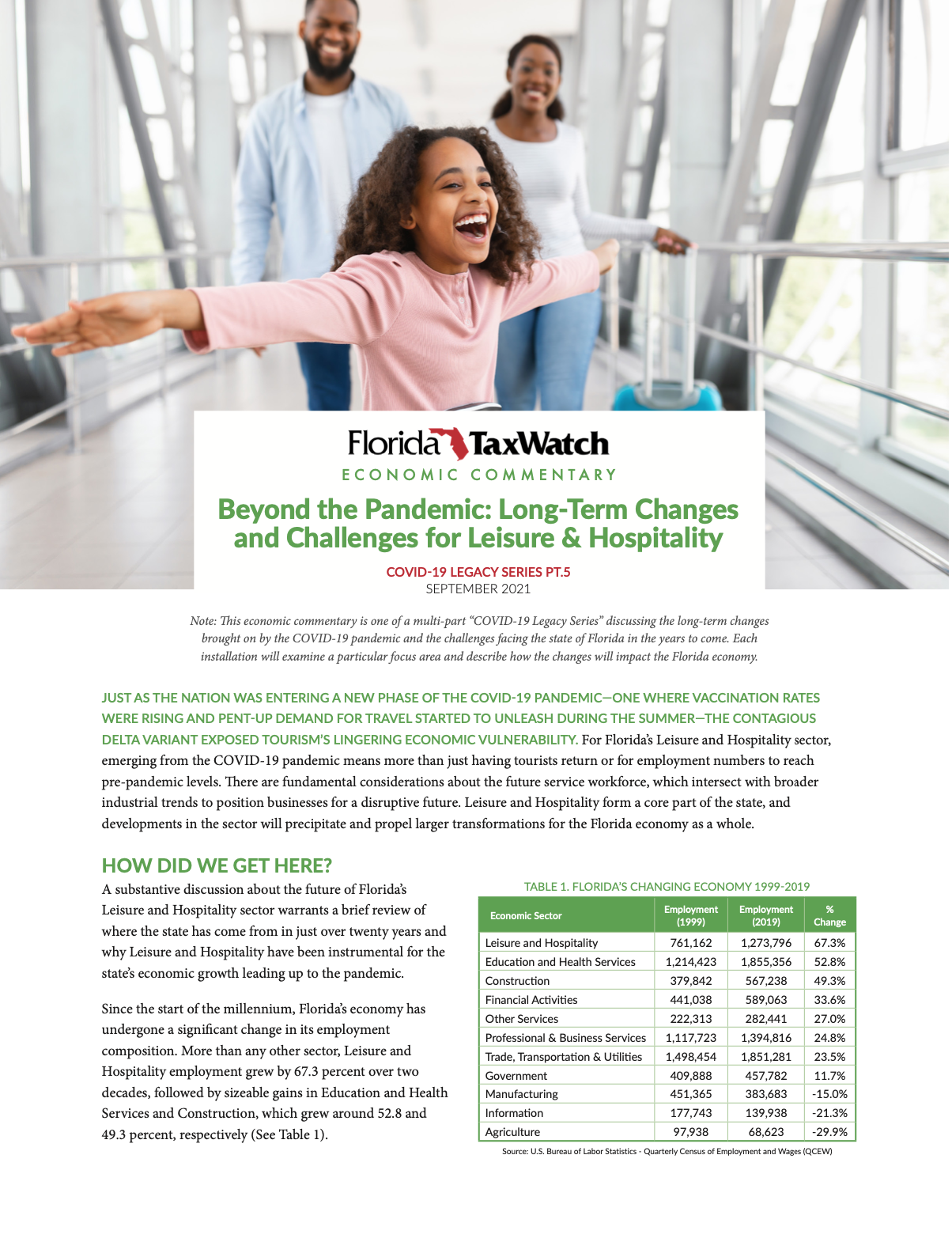Beyond the Pandemic: Long-Term Changes and Challenges for Leisure & Hospitality

Just as the nation was entering a new phase of the COVID-19 pandemic—one where vaccination rates were rising and pent-up demand for travel started to unleash during the summer—the contagious delta variant exposed tourism’s lingering economic vulnerability. For Florida’s Leisure and Hospitality sector, emerging from the COVID-19 pandemic means more than just having tourists return or for employment numbers to reach pre-pandemic levels. There are fundamental considerations about the future service workforce, which intersect with broader industrial trends to position businesses for a disruptive future. Leisure and Hospitality form a core part of the state, and developments in the sector will precipitate and propel larger transformations for the Florida economy as a whole.
Since the start of the millennium, Florida’s economy has undergone a significant change in its employment composition. More than any other sector, Leisure and Hospitality employment grew by 67.3 percent over two decades. The combination of exceptional population growth and elevated annual tourism stimulated economic diversification beyond the state’s historically significant sectors like agriculture and cemented Florida’s position as a global destination and trade leader.
The unrivaled growth in Leisure and Hospitality, in particular, catalyzed a heavy reliance on service industry jobs and a heightened sensitivity to tourism patterns — two features that made Florida extremely vulnerable to the impending pandemic in 2020. It comes by no surprise, then, that the Leisure and Hospitality sector in Florida experienced the most pronounced employment losses of any industry during the pandemic, at one point losing 532,000 jobs in April 2020.
Based on past case studies of major epidemics, the average recovery time for visitor numbers is around 19 months;1 however, given the protracted struggle with COVID-19 and its pervasiveness, the timeline for recovery is uncertain. Despite this tenuous timeline, estimates from Florida’s Office of Economic and Demographic Research (EDR) suggest total visitors may reach 129 million visitors sometime in 2022.2 By the end of the decade, forecasts predict there may be 195 million visitors who visit Florida annually (See Figure 1).3 In terms of tourism returning, EDR expects leisure driving vacations to come back first, followed by business travel, domestic air travel, and international travel.
As evidenced in recent months, Leisure and Hospitality workers across the nation are leaving the sector with over one-third indicating they are not considering reentering the tourism industry.10 Factors such as low pay, lack of benefits, the opportunity for remote work elsewhere, and the ongoing unpredictability have spurred individuals out of the industry.11 Not only are these trends troubling for creating labor shortages across the U.S., but for places like Florida, a lack of Leisure and Hospitality workers produces a negative cascading effect on other industries by potentially constricting the flow of labor in future years.
Structural changes for the Leisure and Hospitality sector also signal macro-changes for Florida’s overall economy down the road. The pandemic presented a renewed sense of urgency for broad economic diversification beyond the former “three-legged stool” model that has typified the state for decades. In emerging areas like health care, information technologies, engineering, and e-commerce, there is abundant opportunity for economic growth. To be clear, Florida will remain heavily service-oriented beyond COVID-19, but that does not preclude the state from pursuing in-demand sectors and improving pathways between service sectors and emerging technological fields. These goals will be imperative for the Florida economy’s longevity and resilience in a dynamically disruptive future.
Documents to download
-
Sep-21-EC(.pdf, 748.44 KB) - 1482 download(s)